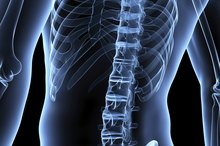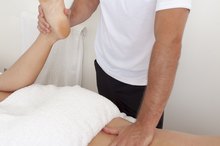Slant Board to Stretch Out Your Back
Slant boards, also known as inversion therapy tables, have been clinically proven to reduce disabling back pain without the use of drugs or surgery. Slant boards enable you to hang upside down while the force of gravity stretches your back. If you suffer back pain caused by disc bulge, disc herniation, degenerative disc disease, facet syndrome or sciatica, a slant board might be a good treatment option. You should consult a doctor before using a slant board for inversion therapy.
If you are experiencing serious medical symptoms, seek emergency treatment immediately.
Proven Benefits of Slant Boards
Energycenter.com published an article that surveyed several studies on inversion therapy 1. In one study, 116 people were tested for 12 months. They were divided into three groups. Groups 1 and 2 were given inversion therapy for 10 minutes either once or twice every day, and Group 3 was the control group. After 12 months, the people in Groups 1 and 2 experienced a 33 percent decrease in sick days due to back pain, which amounted to about eight sick days per individual. The study concluded that inversion therapy is beneficial.
- Energycenter.com published an article that surveyed several studies on inversion therapy 1.
- After 12 months, the people in Groups 1 and 2 experienced a 33 percent decrease in sick days due to back pain, which amounted to about eight sick days per individual.
How the Spine Works
Health Risks of Body Inverters
Learn More
The spine is made up of a series of bones called vertebrae that are connected by ligaments and muscles. It is designed to protect your spinal cord, the superhighway that carries electrical signals from your brain to the rest of your body. Each vertebra is separated by a disc, which has a soft gel-like substance in the center and a fibrous layer around the gel that is tough but flexible. The discs act as shock absorbers to prevent compression fractures of the vertebrae. They provide mobility to your spine by allowing it to bend and twist, and they separate the vertebrae to enable nerve roots to branch off from the spinal cord and travel to the rest of the body.
- The spine is made up of a series of bones called vertebrae that are connected by ligaments and muscles.
- They provide mobility to your spine by allowing it to bend and twist, and they separate the vertebrae to enable nerve roots to branch off from the spinal cord and travel to the rest of the body.
Causes of Back Pain
The intervertebral discs rely on the transfer of fluids and nutrients from the vertebrae above and below. They also depend on a strong outer layer to contain the gel-like inner portion. Excessive weight, poor posture, heavy lifting and repetitive movements can create pressure on the discs that inhibits the transfer of fluids and nutrients, leading to disc dehydration and degeneration. When the discs lose fluid, they shrink and decrease the space between the vertebrae, resulting in bone-on-bone contact that can cause pain. Disc dehydration also causes the outer layer of the disc to become brittle and susceptible to cracks and tears that can lead to disc herniation. Fluid from the inside of the disc can leak through such cracks and bulge out, putting pressure on nerves and causing back pain or sciatica.
- The intervertebral discs rely on the transfer of fluids and nutrients from the vertebrae above and below.
- Excessive weight, poor posture, heavy lifting and repetitive movements can create pressure on the discs that inhibits the transfer of fluids and nutrients, leading to disc dehydration and degeneration.
How Slant Boards Can Alleviate Back Pain
How to Repair a Bulging Disk
Learn More
Slant boards and inversion therapy stretch your back and help increase the space between vertebrae. This type of therapy can greatly reduce the pressure exerted on the discs, which may help draw the gel-like material that has bulged out, or herniated, back into the center of the disc and relieve pressure on the nerves. Reduced pressure also helps the discs draw in the fluids and nutrients needed for proper hydration and can restore proper disc spacing so the vertebrae don’t rub together. By using a slant board regularly, you may be able to diminish the pressure on the vertebrae and reduce back pain.
- Slant boards and inversion therapy stretch your back and help increase the space between vertebrae.
- By using a slant board regularly, you may be able to diminish the pressure on the vertebrae and reduce back pain.
Related Articles
References
Writer Bio
Based in Denver, Jessica Owens is a yoga teacher and a writer. She began writing in college for the school newspaper and currently writes for online publications about health and wellness. She earned a Bachelor of Arts degree from Hamilton College in 2009.









